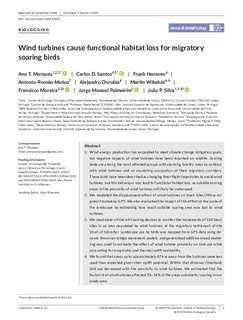| dc.description.abstract | 1 . Wind energy production has expanded to meet climate change mitigation goals, but negative impacts of wind turbines have been reported on wildlife. Soaring birds are among the most affected groups with alarming fatality rates by collision with wind turbines and an escalating occupation of their migratory corridors. These birds have been described as changing their flight trajectories to avoid wind turbines, but this behaviour may lead to functional habitat loss, as suitable soaring areas in the proximity of wind turbines will likely be underused. 2 . We modelled the displacement effect of wind turbines on black kites ( Milvus migrans ) tracked by GPS . We also evaluated the impact of this effect at the scale of the landscape by estimating how much suitable soaring area was lost to wind turbines. 3 . We used state-of-the-art tracking devices to monitor the movements of 130 black kites in an area populated by wind turbines, at the migratory bottleneck of the Strait of Gibraltar. Landscape use by birds was mapped from GPS data using dynamic Brownian bridge movement models, and generalized additive mixed modelling was used to estimate the effect of wind turbine proximity on bird use while accounting for orographic and thermal uplift availability. 4 . We found that areas up to approximately 674 m away from the turbines were less used than expected given their uplift potential. Within that distance threshold, bird use decreased with the proximity to wind turbines. We estimated that the footprint of wind turbines affected 3%–14% of the areas suitable for soaring in our study area. 5 . We present evidence that the impacts of wind energy industry on soaring birds are greater than previously acknowledged. In addition to the commonly reported fatalities, the avoidance of turbines by soaring birds causes habitat losses in their movement corridors. Authorities should recognize this further impact of wind energy production and establish new regulations that protect soaring habitat. We also showed that soaring habitat for birds can be modelled at a fine scale using publicly available data. Such an approach can be used to plan low-impact placement of turbines in new wind energy developments. aerial habitat , avoidance behaviour , migration , orographic uplift , raptor , thermal uplift , wind farms | nb_NO |
